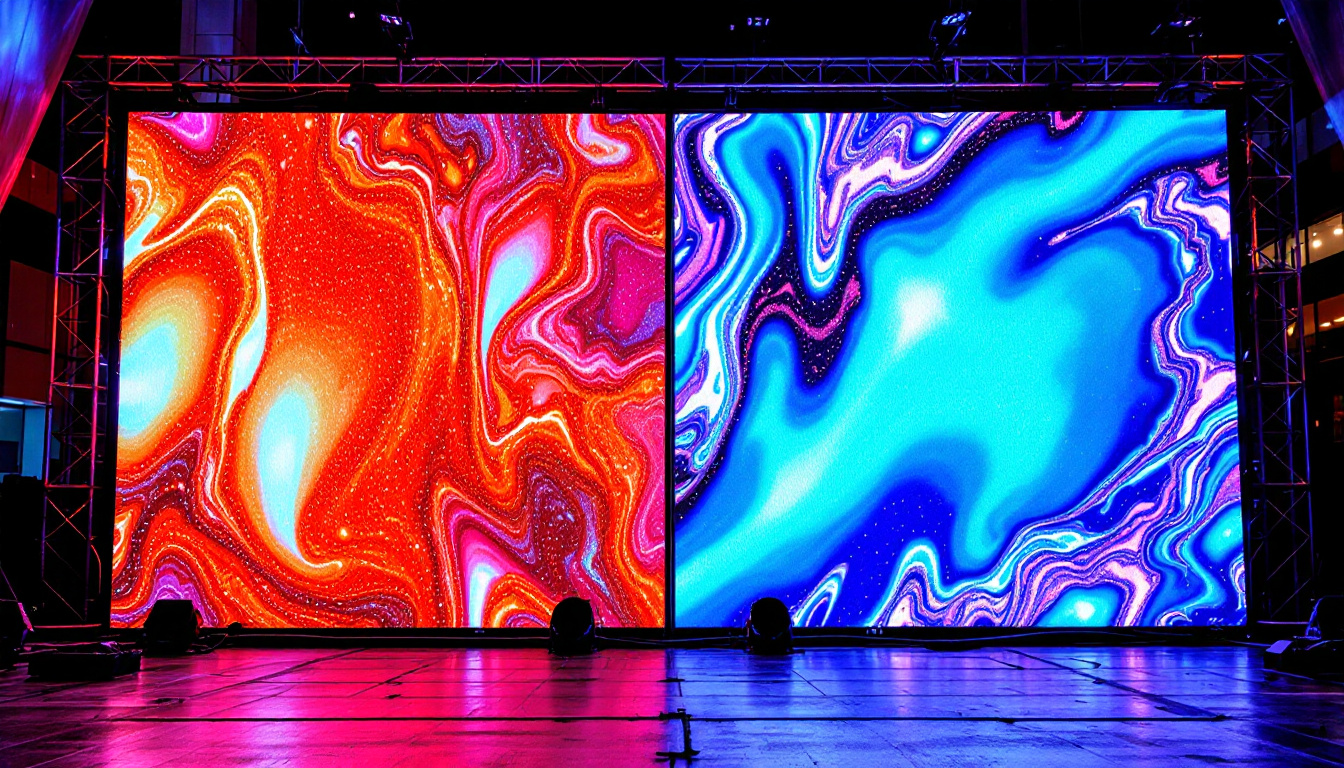In the world of modern technology, displays play a crucial role in how information is conveyed and consumed. Two of the most prevalent types of displays are LED (Light Emitting Diode) and LCD (Liquid Crystal Display). While both technologies serve the purpose of displaying images and videos, they operate on fundamentally different principles and offer distinct advantages and disadvantages. This article delves into the intricacies of LED and LCD displays, comparing their features, benefits, and applications.
Understanding LED Displays
LED displays have gained immense popularity due to their vibrant colors, energy efficiency, and versatility. These displays utilize light-emitting diodes to produce images, making them an essential component in various applications, from televisions to outdoor billboards.
How LED Displays Work
At the core of an LED display is a matrix of tiny light-emitting diodes. Each diode emits light when an electric current passes through it. The combination of red, green, and blue (RGB) diodes allows for a full spectrum of colors to be displayed. Unlike traditional displays that rely on backlighting, LED displays can produce light directly from the diodes, leading to higher brightness and contrast levels.
LED displays can be categorized into two main types: direct LED and edge-lit LED. Direct LED displays feature diodes placed behind the screen, providing uniform brightness across the entire display. Edge-lit LED displays, on the other hand, have diodes positioned along the edges, which light up the screen from the sides. This design is often thinner and more energy-efficient but may result in uneven brightness.
Advantages of LED Displays
LED displays offer several advantages that contribute to their widespread adoption. One of the most significant benefits is energy efficiency. LED technology consumes less power compared to traditional LCD displays, making it an environmentally friendly choice.
Additionally, LED displays provide superior brightness and contrast ratios. This capability allows for better visibility in bright environments, making them ideal for outdoor use. The vibrant colors and sharp images produced by LED displays enhance the viewing experience, whether in a home theater or a commercial setting.
Applications of LED Displays
LED displays are incredibly versatile and can be found in a variety of applications. They are commonly used in televisions, computer monitors, and smartphones. Furthermore, LED technology is prevalent in outdoor advertising, sports arenas, and public transportation systems, where high visibility is essential.
In recent years, LED displays have also made their way into architectural designs, where they are used to create stunning visual effects on building facades. This trend highlights the adaptability of LED technology in both functional and artistic contexts. For instance, some cities have embraced LED displays for digital art installations, transforming urban spaces into dynamic galleries that change with the time of day or season. These installations not only enhance the aesthetic appeal of public areas but also engage communities by providing a platform for local artists to showcase their work.
Moreover, the rise of smart technology has further expanded the capabilities of LED displays. With the integration of IoT (Internet of Things), these displays can now be connected to the internet, allowing for real-time updates and interactivity. This feature is particularly beneficial for advertising, where businesses can modify their content instantly based on audience engagement or current events, making their marketing strategies more effective and timely. As technology continues to evolve, the future of LED displays promises even more innovative applications that will reshape how we interact with visual media.
Understanding LCD Displays
LCD displays have been a staple in the display technology landscape for decades. They utilize liquid crystals to manipulate light and create images. While LCD technology has its own set of advantages, it also comes with certain limitations compared to LED displays.
How LCD Displays Work
LCD displays consist of a liquid crystal solution sandwiched between two layers of glass or plastic. When an electric current is applied, the liquid crystals align to either block or allow light to pass through. This manipulation of light creates images on the screen.
Unlike LED displays, which emit light, LCD displays require a backlight to illuminate the liquid crystals. This backlighting is typically provided by fluorescent lamps or LEDs. The quality of the backlight significantly impacts the overall performance of the LCD display, influencing brightness, color accuracy, and contrast.
Advantages of LCD Displays
One of the primary advantages of LCD displays is their cost-effectiveness. They are generally less expensive to manufacture than LED displays, making them a popular choice for budget-conscious consumers. Additionally, LCD displays can achieve high resolutions, offering sharp images suitable for various applications.
LCD technology also provides a wide viewing angle, allowing multiple viewers to enjoy the content without significant color distortion. This feature makes LCD displays ideal for environments where several people may be watching the screen simultaneously, such as in conference rooms or classrooms.
Applications of LCD Displays
LCD displays are commonly used in televisions, computer monitors, and smartphones. They are also prevalent in medical devices, where high-resolution images are crucial for accurate diagnoses. Furthermore, LCD technology is often utilized in automotive displays, providing drivers with essential information in a clear and concise manner.
While LCD displays may not offer the same level of brightness as LED displays, they remain a reliable choice for many applications, particularly in indoor settings where lighting conditions can be controlled.
Comparing LED and LCD Displays
When evaluating LED and LCD displays, it is essential to consider various factors, including performance, cost, and intended use. Understanding these differences can help consumers make informed decisions based on their specific needs.
Performance
In terms of performance, LED displays generally outperform LCD displays in several key areas. LED displays offer higher brightness levels, resulting in better visibility in bright environments. They also provide superior contrast ratios, enhancing the overall viewing experience.
Furthermore, LED displays tend to have faster response times, making them ideal for fast-paced content such as video games and sports. This responsiveness reduces motion blur, resulting in smoother visuals. Conversely, LCD displays may struggle with fast-moving images, leading to a less enjoyable viewing experience.
Cost
Cost is a significant factor for many consumers when choosing between LED and LCD displays. Generally, LCD displays are more affordable than LED displays, making them an attractive option for budget-conscious buyers. However, the price difference has been narrowing as LED technology becomes more mainstream.
While the initial investment for an LED display may be higher, the long-term savings in energy consumption and durability can offset the upfront costs. It is essential to weigh these factors when considering the overall value of each display type.
Intended Use
The intended use of the display plays a crucial role in determining which technology is best suited for a particular application. For instance, LED displays are ideal for outdoor environments where brightness and visibility are paramount. They are also well-suited for applications requiring vibrant colors and high contrast.
On the other hand, LCD displays are often preferred for indoor settings where lighting conditions can be controlled. Their wide viewing angles and cost-effectiveness make them suitable for environments such as offices, classrooms, and homes.
Future Trends in Display Technology
The landscape of display technology is continually evolving, with advancements in both LED and LCD technologies. As consumer demands change, manufacturers are exploring innovative solutions to enhance display performance and user experience.
Emerging Technologies
One of the most exciting developments in display technology is the rise of OLED (Organic Light Emitting Diode) displays. OLED technology combines the benefits of LED and LCD displays, offering superior color accuracy, contrast, and flexibility. Unlike traditional LED displays, OLED panels do not require a backlight, allowing for thinner designs and improved energy efficiency.
MicroLED is another emerging technology that promises to revolutionize the display industry. MicroLED displays utilize tiny, individual LEDs to create images, offering exceptional brightness, color accuracy, and energy efficiency. This technology has the potential to compete with OLED displays while addressing some of their limitations, such as burn-in issues.
Sustainability and Energy Efficiency
As environmental concerns continue to grow, manufacturers are placing a greater emphasis on sustainability and energy efficiency in display technology. Both LED and LCD displays are becoming more eco-friendly, with advancements in materials and production processes aimed at reducing their carbon footprint.
Energy-efficient displays not only benefit the environment but also provide cost savings for consumers. As technology continues to advance, it is likely that future displays will prioritize sustainability without compromising performance.
Integration with Smart Technology
The integration of display technology with smart devices and the Internet of Things (IoT) is another trend shaping the future of displays. Smart displays equipped with advanced features, such as voice control and connectivity, are becoming increasingly popular in homes and workplaces.
This integration allows for seamless interaction between users and their displays, enhancing the overall experience. As smart technology continues to evolve, the capabilities of LED and LCD displays will likely expand, offering new possibilities for users.
Conclusion
In conclusion, both LED and LCD displays have their unique advantages and applications. LED displays are known for their superior brightness, contrast, and energy efficiency, making them ideal for outdoor use and vibrant content. Conversely, LCD displays offer cost-effectiveness and wide viewing angles, making them suitable for various indoor applications.
When choosing between LED and LCD displays, it is essential to consider performance, cost, and intended use. As technology continues to advance, both display types will likely evolve, offering consumers even more options to suit their needs.
Ultimately, understanding the differences between LED and LCD displays empowers consumers to make informed decisions, ensuring they select the right technology for their specific requirements. Whether for personal use, professional settings, or commercial applications, the right display can significantly enhance the viewing experience.
Discover LumenMatrix LED Display Solutions
Ready to elevate your visual experience with the latest in display technology? Look no further than LumenMatrix, a pioneer in LED display innovation. Our extensive range of products, from Indoor and Outdoor LED Wall Displays to specialized solutions like Vehicle and Sports LED Displays, is designed to bring your vision to life with unparalleled brightness, contrast, and energy efficiency. Whether you’re looking to create an immersive environment with a Floor LED Display or make a bold statement with a Custom LED Display, LumenMatrix has the perfect solution to fit your needs. Embrace the future of visual communication and check out LumenMatrix LED Display Solutions today to see how we can help you captivate your audience and amplify your message with clarity and impact.































